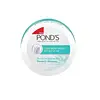What's inside
What's inside
 Key Ingredients
Key Ingredients

 Benefits
Benefits

 Concerns
Concerns

 Ingredients Side-by-side
Ingredients Side-by-side

Water
Skin ConditioningAloe Barbadensis Leaf Juice
Skin ConditioningAmmonium Acryloyldimethyltaurate/Vp Copolymer
Argania Spinosa Kernel Oil
EmollientBetaine
HumectantCamellia Sinensis Leaf Extract
AntimicrobialParfum
MaskingCI 19140
Cosmetic ColorantCI 42090
Cosmetic ColorantGlycolic Acid
BufferingEthylhexylglycerin
Skin ConditioningGlycyrrhiza Glabra Root Extract
BleachingGinkgo Biloba Leaf Extract
Skin ConditioningLycium Barbarum Fruit Extract
AstringentPhenoxyethanol
PreservativeSalix Alba Bark Extract
AstringentWater, Aloe Barbadensis Leaf Juice, Ammonium Acryloyldimethyltaurate/Vp Copolymer, Argania Spinosa Kernel Oil, Betaine, Camellia Sinensis Leaf Extract, Parfum, CI 19140, CI 42090, Glycolic Acid, Ethylhexylglycerin, Glycyrrhiza Glabra Root Extract, Ginkgo Biloba Leaf Extract, Lycium Barbarum Fruit Extract, Phenoxyethanol, Salix Alba Bark Extract
Water
Skin ConditioningDimethicone
EmollientGlycerin
HumectantButylene Glycol
HumectantAmmonium Acryloyldimethyltaurate/Vp Copolymer
Niacinamide
SmoothingLinoleamidopropyl Pg-Dimonium Chloride Phosphate
Phenoxyethanol
PreservativeAmmonium Acryloyldimethyltaurate/Beheneth-25 Methacrylate Crosspolymer
Emulsion StabilisingParfum
MaskingSodium PCA
HumectantDisodium EDTA
Stearic Acid
CleansingCaprylic/Capric Triglyceride
MaskingTocopheryl Acetate
AntioxidantTriethanolamine
BufferingBHT
AntioxidantIodopropynyl Butylcarbamate
PreservativeSodium Hyaluronate Crosspolymer
HumectantSodium Hyaluronate
HumectantSodium Acetylated Hyaluronate
HumectantHydrolyzed Hyaluronic Acid
HumectantPentylene Glycol
Skin ConditioningEthylhexylglycerin
Skin ConditioningCitral
PerfumingCitronellol
PerfumingGeraniol
PerfumingHexyl Cinnamal
PerfumingLimonene
PerfumingLinalool
PerfumingCI 42090
Cosmetic ColorantWater, Dimethicone, Glycerin, Butylene Glycol, Ammonium Acryloyldimethyltaurate/Vp Copolymer, Niacinamide, Linoleamidopropyl Pg-Dimonium Chloride Phosphate, Phenoxyethanol, Ammonium Acryloyldimethyltaurate/Beheneth-25 Methacrylate Crosspolymer, Parfum, Sodium PCA, Disodium EDTA, Stearic Acid, Caprylic/Capric Triglyceride, Tocopheryl Acetate, Triethanolamine, BHT, Iodopropynyl Butylcarbamate, Sodium Hyaluronate Crosspolymer, Sodium Hyaluronate, Sodium Acetylated Hyaluronate, Hydrolyzed Hyaluronic Acid, Pentylene Glycol, Ethylhexylglycerin, Citral, Citronellol, Geraniol, Hexyl Cinnamal, Limonene, Linalool, CI 42090
 Reviews
Reviews

Ingredients Explained
These ingredients are found in both products.
Ingredients higher up in an ingredient list are typically present in a larger amount.
Ammonium Acryloyldimethyltaurate/Vp Copolymer (let's call it AAVC for short) is a synthetically created polymer. It's used as a film-forming agent and used to thicken the consistency of products.
AAVC is able to increase the consistency and viscosity of products due to its large molecule size. It also prevents ingredients from separating.
Ci 42090 is a synthetic dye created from petroleum. It is used to give a bright blue color to cosmetics, medicine, and food.
Ethylhexylglycerin (we can't pronounce this either) is commonly used as a preservative and skin softener. It is derived from glyceryl.
You might see Ethylhexylglycerin often paired with other preservatives such as phenoxyethanol. Ethylhexylglycerin has been found to increase the effectiveness of these other preservatives.
Parfum is a catch-all term for an ingredient or more that is used to give a scent to products.
Also called "fragrance", this ingredient can be a blend of hundreds of chemicals or plant oils. This means every product with "fragrance" or "parfum" in the ingredients list is a different mixture.
For instance, Habanolide is a proprietary trade name for a specific aroma chemical. When used as a fragrance ingredient in cosmetics, most aroma chemicals fall under the broad labeling category of “FRAGRANCE” or “PARFUM” according to EU and US regulations.
The term 'parfum' or 'fragrance' is not regulated in many countries. In many cases, it is up to the brand to define this term.
For instance, many brands choose to label themselves as "fragrance-free" because they are not using synthetic fragrances. However, their products may still contain ingredients such as essential oils that are considered a fragrance by INCI standards.
One example is Calendula flower extract. Calendula is an essential oil that still imparts a scent or 'fragrance'.
Depending on the blend, the ingredients in the mixture can cause allergies and sensitivities on the skin. Some ingredients that are known EU allergens include linalool and citronellol.
Parfum can also be used to mask or cover an unpleasant scent.
The bottom line is: not all fragrances/parfum/ingredients are created equally. If you are worried about fragrances, we recommend taking a closer look at an ingredient. And of course, we always recommend speaking with a professional.
Learn more about ParfumPhenoxyethanol is a preservative that has germicide, antimicrobial, and aromatic properties. Studies show that phenoxyethanol can prevent microbial growth. By itself, it has a scent that is similar to that of a rose.
It's often used in formulations along with Caprylyl Glycol to preserve the shelf life of products.
Water. It's the most common cosmetic ingredient of all. You'll usually see it at the top of ingredient lists, meaning that it makes up the largest part of the product.
So why is it so popular? Water most often acts as a solvent - this means that it helps dissolve other ingredients into the formulation.
You'll also recognize water as that liquid we all need to stay alive. If you see this, drink a glass of water. Stay hydrated!
Learn more about Water